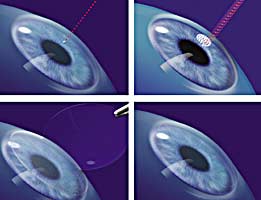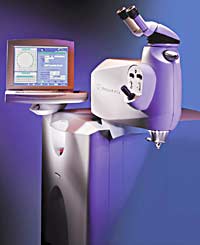IntraLase creates consistently thin flaps
| |
As an optometrist and co-owner of a busy laser vision center in the Dallas-Ft. Worth Metro plex, I would like to share my experience with the use of the femtosecond laser.
My partner and I purchased a femtosecond laser in April 2003. The driving force behind the purchase of this device was to dramatically reduce flap complications created by mechanical microkeratomes. We had performed more than 7,500 successful microkeratome procedures; however, we have had patients with epithelial defects, buttonhole flaps and partial flaps. Even though none of these complications has been sight-threatening, they do require an inordinate amount of time to manage. Also, patients who have complications tend to discuss them with their friends, family and co-workers, thereby keeping many patients from having laser vision correction. We felt there had to be a better way.
After conferring with colleagues and reviewing the data from the Food and Drug Administration clinical trials, we elected to purchase a femtosecond laser from the IntraLase Corp. (Irvine, Calif.). Ours was the 49th laser delivered, and at the time of the writing of this article, 106 lasers have been placed worldwide. Nine percent of all corneal flaps this year have been created with the femtosecond laser, and this number will continue to grow as more lasers are placed. To date, 111,830 flaps have been created with the femtosecond laser, and no partial flaps, no buttonhole flaps, no epithelial sloughs and no free caps have been reported.
How it works
The laser is a solid-state device that uses infrared light in short pulses (measured in femtoseconds). Using a spot size of about 3 µm, the laser places tiny bursts of energy at a prescribed depth in the stroma, creating a microscopic cavitation bubble of carbon dioxide and water vapor. A computer delivers an interconnecting series of these pulses to create a dissection plane. Also, the surgeon has the ability to customize the flaps either by thickness or hinge location, thereby providing much greater flexibility than can be attained with current microkeratomes.
|
|
Learning curve
The learning curve on this instrument is much shorter on the surgeon than the microkeratome. It took us about 2 surgical days and approximately 100 eyes before we felt very comfortable with the technology. However, it takes about 45 to 50 seconds to create a flap with the femtosecond laser as opposed to 10 to 12 seconds with a keratome. Also, in some patients, the gas bubbles become opaque and may require a 10- to 15-minute wait for the bubbles to dissipate before lifting the flap for treatment. Patient flow was modified slightly to compensate for these changes.
Patient preference
Since we installed the laser, 95% of our patients have chosen IntraLase technology over the traditional microkeratome even though there is an increase in the fee. It has been our experience that today’s patients prefer the most precise and uniquely safe way to have laser vision correction, and the fee has not been a significant deterrent to proceeding with IntraLase. In fact, many patients tell me that when they learned that no blade would be used during their surgery, it gave them the confidence to move forward.
To date, we have not had a single flap complication or epithelial defect, nor have any procedures had to be aborted due to loss of suction, as can be the case with mechanical microkeratomes.
|
|
Thinner flaps, planar flaps
The advantages of having a femtosecond laser are numerous, but, for us, it is the ability to create consistently thin flaps allowing for more tissue in the residual bed. Initially, our laser was defaulted to create 100-µm flaps; however, we now routinely create 90-µm flaps. With subtraction pachymetry, our flaps are measuring within ±15 µm of intended thickness. On our mechanical microkeratome with subtraction pachymetry, our results are ±60 µm of intended thickness. With the addition of this technology, we can now treat patients with thinner corneas than we would have treated with traditional LASIK and still leave more residual tissue in the stromal bed.
In addition to thinner flaps, the femtosecond laser creates planar flaps (same thickness from edge to edge) vs. the meniscus flaps created with the microkeratome. The results of one randomized prospective study show that patients see better with flaps created with the femtosecond laser than mechanical microkeratomes (“Prospective, randomized, single-center clinical trial of IntraLase FS Laser vs. Hansatome in 51 patients treated with CustomCornea.” Presented at ISRS/AAO 2003 by Daniel Durrie, MD. Another benefit of planar flaps is that they actually create fewer higher- and lower-order aberrations, which aids in improvement of visual acuity.
Postop care, appearance
With respect to postoperative care, our regimen is no different than with the mechanical microkeratome, and visual recovery is essentially the same as well. The only visible difference is the appearance of the flap over time. Flaps created with the femtosecond laser have very well-defined borders, and the outline of the flap is much easier to see than the borders created with the manual microkeratome.
Although I purchased the femtosecond technology to create flaps, the laser is by no means limited to just this application. The laser can cut Intacs (Addition Technology, Des Plaines, Ill.) tunnels and is used in both anterior and posterior lamellar corneal transplants, and the potential exists to someday perform a non-invasive stromal refractive change.
For Your Information:References:
- The IntraLase femtosecond laser is available from IntraLase Corp., 3 Morgan, CA 92618; (877) 393-2020; www.intralase.com.
- “Microkeratome use in conventional LASIK and the use of the IntraLase FS laser to create corneal flaps: the all-laser procedure,” accepted: J Cat Ref Surg August 2003.
- “Femtosecond laser minimizes wavefront distortions.” Author Dan Tran, MD. Submitted: J Cat Ref Surg July 2003.

![Wally Ryne [photo]](/~/media/images/news/print/primary-care-optometry-news/2004/03_march/wryne_60_90_69407.jpg) Wally Ryne, OD, FAAO, is clinical director of Clearview Laser Vision Center in Grapevine, Texas. He can be reached at 1643 Lancaster Dr., Suite 301, Grapevine, TX 76051; (817) 329-2700; fax: (817) 329-8322; e-mail:
Wally Ryne, OD, FAAO, is clinical director of Clearview Laser Vision Center in Grapevine, Texas. He can be reached at 1643 Lancaster Dr., Suite 301, Grapevine, TX 76051; (817) 329-2700; fax: (817) 329-8322; e-mail: 

